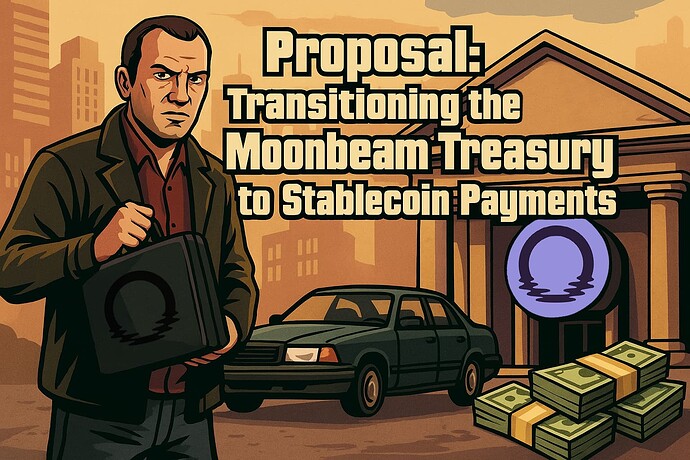Summary
We, the @TreasuryCouncil, propose enabling the Moonbeam Treasury to make payments in stablecoins for service providers that rely on real-world US-Dollar or Euro expenses. To achieve this, we suggest adopting a systematic Dollar-Cost Averaging (DCA) strategy to convert a portion of the Treasury’s GLMR tokens to USDC or USDT. This approach would reduce the total token expenditure, minimize volatility-related overhead, and improve financial predictability for all parties involved.
Background and Rationale
The Treasury Council has identified a recurring challenge: Funding services with real-world US-Dollar or Euro expenses while paying in GLMR tokens, which fluctuate in fiat based value. Currently, we’re using a 30-day Exponential Moving Average (EMA) to account for these volatilities, while at the same time many treasury proposals include safety margins to additionally compensate for token price fluctuations either explicitly or implicitly.
We firmly believe that the Treasury could reduce its total token expenditure by paying out in stablecoins for real-world expenses that ultimately need to be converted to fiat currencies. This approach has precedent in the Polkadot ecosystem, where the Polkadot Treasury has been gradually converting DOT to USDC and USDT and moved to stablecoin payouts.
Technical Implementation
We propose leveraging Hydration Network’s Omnipool for GLMR token conversion through a DCA strategy using XCM and our sovereign account on Hydration. This method ensures trades will be split into small enough chunks over an extended period of time to minimize slippage and prevent arbitrage opportunities.
The implementation flow would be as follows:
- Transfer GLMR funds from the Moonbeam Treasury account to the Moonbeam sovereign account in Hydration
- Create a DCA schedule to swap the GLMR tokens for USDC/USDT at predetermined intervals
- Transfer the acquired stablecoins back to Moonbeam via XCM
The XCM call would allow for either selling fixed amounts of GLMR or purchasing fixed amounts of stablecoins, providing flexibility in our approach. The code to generate the call data is available at
PolkaTools/treasuryDCAHydration.ts at main · albertov19/PolkaTools · GitHub (commit hash 5946d9f3545ac22812a7dd4e0ce3e34e2a27ca71)
The Treasury Council has thoroughly discussed technical aspects with MBF’s XCM specialist, Alberto, who will provide support throughout the potential implementation process.
Market Impact Considerations
To minimize market impact on GLMR, we propose starting with converting just 25% of the estimated monthly constant treasury inflow to stablecoins. This conservative approach would establish a stablecoin reserve without significantly impacting GLMR price and allow us to stay solvent with GLMR payments at the same time over the duration of the transition period.
In absolute numbers, this would translate to approximately 1,000 GLMR per day being converted to stablecoins — a minimal amount compared to GLMR’s daily trading volume, GLMR-Stablecoin pool’s depth’s on major DEX’es and other relevant metrics.
Additionally, we propose implementing a lower-bound price threshold of $0.045 as a protective measure. If GLMR’s price were to drop below this threshold (approximately one third or 35% below its current value of ~$0.069 at the time of posting), the conversion would temporarily pause until the minimum price threshold is reached.
Anticipated Benefits
-
Reduced Treasury Expenditure: By paying directly in stablecoins for real-world expenses, we eliminate the need for safety margins that compensate for price volatility.
-
Improved Budget Predictability: Recipients with fiat expenses will have certainty about the dollar value of their treasury grants.
-
Lower Price Impact: DCA strategy distributes selling pressure over time, resulting in less market impact compared to lump-sum conversions by grant recipients.
-
Treasury Resilience: Building a stablecoin reserve improves the Treasury’s ability to fund critical infrastructure and operations during bear markets.
-
Less Friction: Stable payouts reduce concerns about price swings affecting grant values.
Implementation Timeline
Runtime upgrade RT3700 is scheduled to come into affect in June, providing the technical capabilities to the on-chain Treasury for stablecoin payouts to be executed. Building a substantial reserve of stablecoins to leverage for significant expenses is likely to require a more considerable amount of time.
For now, this program will only affect the Moonbeam Treasury, not the Moonriver Treasury, due to technical considerations.
Despite recent market movements, we believe this strategy to be appropriate regardless of market timing, as expenses need to be paid regardless, and through this program, are expected to be reduced in total GLMR terms. Spreading trades over time will minimize market impacts and ensure best averaged value. Additionally, some diversification is generally perceived to have a net positive effect towards both risk-aversion and performance.
Should this proposal be perceived positively overall, we the Treasury Council may consider to kick things off in due time.
Community Feedback Requested
Beyond general support or opposition, we welcome community feedback on several key aspects of this proposal:
-
Stablecoin Selection: Do you prefer USDC or USDT as the primary stablecoin for treasury diversification?
-
Conversion Percentage: Is 25% of treasury inflows an appropriate starting point? Should this be higher or lower?
-
Price Threshold: Is $0.045 an appropriate lower bound for GLMR price to pause conversions?
This proposal is meant to initiate a conversation about optimizing our treasury operations. We welcome your thoughts, concerns, and suggestions as we work together to build a more continuously resilient and efficient Treasury for the Moonbeam ecosystem.
